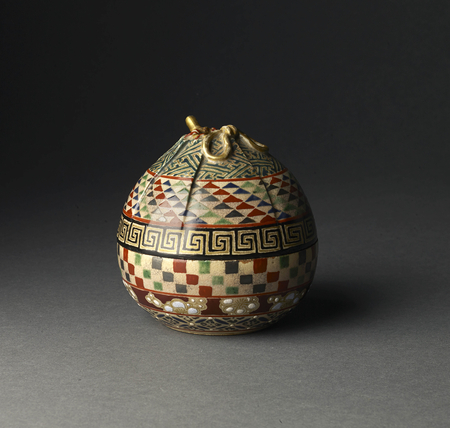Product Description
7067 A ceramic kōro (incense burner) painted in coloured enamel in the form of a Japanese silk bag
Impressed seal mark: Kahin Shiryū
Japan 19th century Edo period
Dimensions: H. 9cm x Diam. 9cm (3¾” x 3¾”)
Tomobako (wood box) inscribed:
Lid paper cover: Kōro fukuro gata Kahin Shiryū zō (An incense burner in a shape of a bag made by Kahin Shiryū)
Label on box lid: Eiraku fukuro gata kōro (Made by Eiraku. An incense burner in the shape of a bag)
Eiraku Hozen (1795-1854). An 11th generation potter, he was the first to use the name Eiraku after the 10th Lord of Kishū-Tokugawa domain (Mie and Wakayama Perfectures) Tokugawa Harutomi (1771-1853), had granted him the Eiraku and the Kahin Shiryū artist’s seal in 1827. Hozen was said to have founded the Kiirakuen kiln, the official kiln of the Kii branch of the Togugawa family located in Kii province. He was familiar with all porcelain and stoneware techniques but was especially successful in mastering Chinese Ming dynasty pottery techniques such as akaji kinran de (gold decoration on an iron red glaze), fashionable in Kyoto during the late Edo period (1603-1867) he excelled his contemporaries in over glaze enamels. Along with Aoki Mokubei (1767-1833) and Nin’ami Dohachi II (1783-1855) he is considered one of the three most important master potters of 19th century Kyoto.
Works by the artist can be found in the collections of: Tokyo National Museum; The Metropolitan Museum of Art, New York; British Museum, London; The Ashmolean Museum, Oxford; Freer & Sackler Museum of Asian Art, Washington D.C.; Itsuō Art Museum, Osaka.








